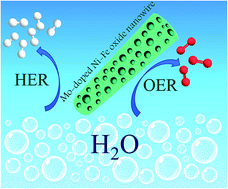Hierarchically porous Mo-doped Ni–Fe oxide nanowires efficiently catalyzing oxygen/hydrogen evolution reactions†
Abstract
Developing cost-effective, active and robust electrocatalysts for the hydrogen evolution reaction (HER) and the oxygen evolution reaction (OER) in the same electrolyte still remains a crucial challenge for boosting the efficient conversion of sustainable energy resources. Here, based upon rapid solidification and the dealloying inheritance effect, a eutectic-derived self-templating strategy is reported to fabricate hierarchically porous Mo-doped Ni–Fe oxide nanowires for catalyzing overall water splitting. The advanced catalyst exhibits a remarkably low overpotential (only requires an overpotential of 231 mV for 10 mA cm−2) and low Tafel slope (39 mV dec−1) towards the OER in 1 M KOH. Comparing with the Ni–Fe oxide without Mo-doping, the Mo-doped Ni–Fe oxide nanowires show enhanced activities towards the HER with 84 mV less overpotential to drive a current density of 10 mA cm−2. Strikingly, an alkaline electrolyzer assembled by using the Mo-doped Ni–Fe oxide nanowires as both the anode and the cathode consumes a cell voltage as low as 1.62 V (at 10 mA cm−2). The exceptional properties of the catalyst can be ascribed to its well-designed hierarchically porous nanowire network, and enhanced electric conductivity profiting from the remaining Ni metal in the oxide, as well as the synergistic effect of Mo and the Ni–Fe system. These favorable factors concurrently contribute to the boosted active surface area, facilitated electron/electrolyte transport, and accelerated reaction kinetics of water splitting.



 Please wait while we load your content...
Please wait while we load your content...